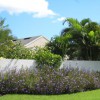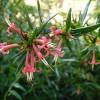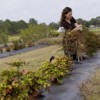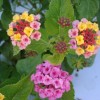 Environmental tolerance, abundant seed production, and an ability to easily grow from plant stem sections have allowed Mexican petunia to spread into natural areas that border urban areas. The Florida Exotic Pest Plant Council lists Mexican petunia (wild-type and non-sterile cultivars) as a Category 1 invasive species, meaning that it is “altering native plant communities by displacing native species, changing community structures or ecological functions, or hybridizing with natives”. These potential changes to community structure and ecological function are of particular concern in Florida wetlands, where changes to plant communities have the potential to impact not just plant-animal interactions, but also overall hydrology on a whole watershed level. This 6-page fact sheet was written by C. A. Reinhardt Adams, C. Wiese, L.C. Lee, S.B. Wilson, A. M. Smith, and R. Freyre, and published by the UF Department of Environmental Horticulture, April 2014.
Environmental tolerance, abundant seed production, and an ability to easily grow from plant stem sections have allowed Mexican petunia to spread into natural areas that border urban areas. The Florida Exotic Pest Plant Council lists Mexican petunia (wild-type and non-sterile cultivars) as a Category 1 invasive species, meaning that it is “altering native plant communities by displacing native species, changing community structures or ecological functions, or hybridizing with natives”. These potential changes to community structure and ecological function are of particular concern in Florida wetlands, where changes to plant communities have the potential to impact not just plant-animal interactions, but also overall hydrology on a whole watershed level. This 6-page fact sheet was written by C. A. Reinhardt Adams, C. Wiese, L.C. Lee, S.B. Wilson, A. M. Smith, and R. Freyre, and published by the UF Department of Environmental Horticulture, April 2014.
http://edis.ifas.ufl.edu/ep498
Tag: Rosanna Freyre
Alternatives to Invasive Plants Commonly Found in South Florida Landscapes
 Based on years of UF/IFAS research producing and trialing cultivars, this 5-page fact sheet lists native and non-invasive, non-native ornamentals as alternatives to invasive plants commonly used in Florida landscapes. Only plants considered to be generally available in the nursery trade are listed. Alternative plants are similar to respective invasive plants as much as possible in terms of size, habit, texture, and flower color. Written by Gary W. Knox, Sandra B. Wilson, Zhanao Deng, and Rosanna Freyre, and published by the UF Department of Environmental Horticulture, September 2013.
Based on years of UF/IFAS research producing and trialing cultivars, this 5-page fact sheet lists native and non-invasive, non-native ornamentals as alternatives to invasive plants commonly used in Florida landscapes. Only plants considered to be generally available in the nursery trade are listed. Alternative plants are similar to respective invasive plants as much as possible in terms of size, habit, texture, and flower color. Written by Gary W. Knox, Sandra B. Wilson, Zhanao Deng, and Rosanna Freyre, and published by the UF Department of Environmental Horticulture, September 2013.
http://edis.ifas.ufl.edu/ep483
Alternatives to Invasive Plants Commonly Found in Central Florida Landscapes
 Based on years of UF/IFAS research producing and trialing cultivars, this 3-page fact sheet lists native and non-invasive, non-native ornamentals as alternatives to invasive plants commonly used in Central Florida landscapes. Only plants considered to be generally available in the nursery trade are listed. Alternative plants are similar to respective invasive plants as much as possible in terms of size, habit, texture, and flower color. This 3-page fact sheet was written by Gary W. Knox, Sandra B. Wilson, Zhanao Deng, and Rosanna Freyre, and published by the UF Department of Environmental Horticulture, August 2013.
Based on years of UF/IFAS research producing and trialing cultivars, this 3-page fact sheet lists native and non-invasive, non-native ornamentals as alternatives to invasive plants commonly used in Central Florida landscapes. Only plants considered to be generally available in the nursery trade are listed. Alternative plants are similar to respective invasive plants as much as possible in terms of size, habit, texture, and flower color. This 3-page fact sheet was written by Gary W. Knox, Sandra B. Wilson, Zhanao Deng, and Rosanna Freyre, and published by the UF Department of Environmental Horticulture, August 2013.
http://edis.ifas.ufl.edu/ep468
Alternatives to Invasive Plants Commonly Found in North Florida Landscapes (ENH1206/EP467)
 Based on years of UF/IFAS research producing and trialing cultivars, this 3-page fact sheet lists native and non-invasive, non-native ornamentals as alternatives to invasive plants commonly used in Florida landscapes. Only plants considered to be generally available in the nursery trade are listed. Alternative plants are similar to respective invasive plants as much as possible in terms of size, habit, texture, and flower color.was written by Gary W. Knox, Sandra B. Wilson, Zhanao Deng, and Rosanna Freyre, and published by the UF Department of Environmental Horticulture, August 2013.
Based on years of UF/IFAS research producing and trialing cultivars, this 3-page fact sheet lists native and non-invasive, non-native ornamentals as alternatives to invasive plants commonly used in Florida landscapes. Only plants considered to be generally available in the nursery trade are listed. Alternative plants are similar to respective invasive plants as much as possible in terms of size, habit, texture, and flower color.was written by Gary W. Knox, Sandra B. Wilson, Zhanao Deng, and Rosanna Freyre, and published by the UF Department of Environmental Horticulture, August 2013.
http://edis.ifas.ufl.edu/ep467
UF-T3 and UF-T4: Two Sterile Lantana camara Varieties (ENH1202/EP463)
 Lantana camara plants are valued for their bright flower color, butterfly attraction, tolerance to harsh environmental conditions, low maintenance requirements, and ease of propagation and production. But many existing varieties can be weedy or invasive when grown in tropical and subtropical regions. So in 2004, UF/IFAS started a program to develop sterile L. camara varieties with little to no invasive potential.
Lantana camara plants are valued for their bright flower color, butterfly attraction, tolerance to harsh environmental conditions, low maintenance requirements, and ease of propagation and production. But many existing varieties can be weedy or invasive when grown in tropical and subtropical regions. So in 2004, UF/IFAS started a program to develop sterile L. camara varieties with little to no invasive potential.
This 8-page fact sheet introduces the recently released UF-T3 and UF-T4 lantana varieties that have resulted from these breeding, selection, and testing efforts. Written by Zhanao Deng, David M. Czarnecki II, Sandra B. Wilson, Gary W. Knox, and Rosanna Freyre, and published by the UF Department of Environmental Horticulture, August 2012.
http://edis.ifas.ufl.edu/ep463